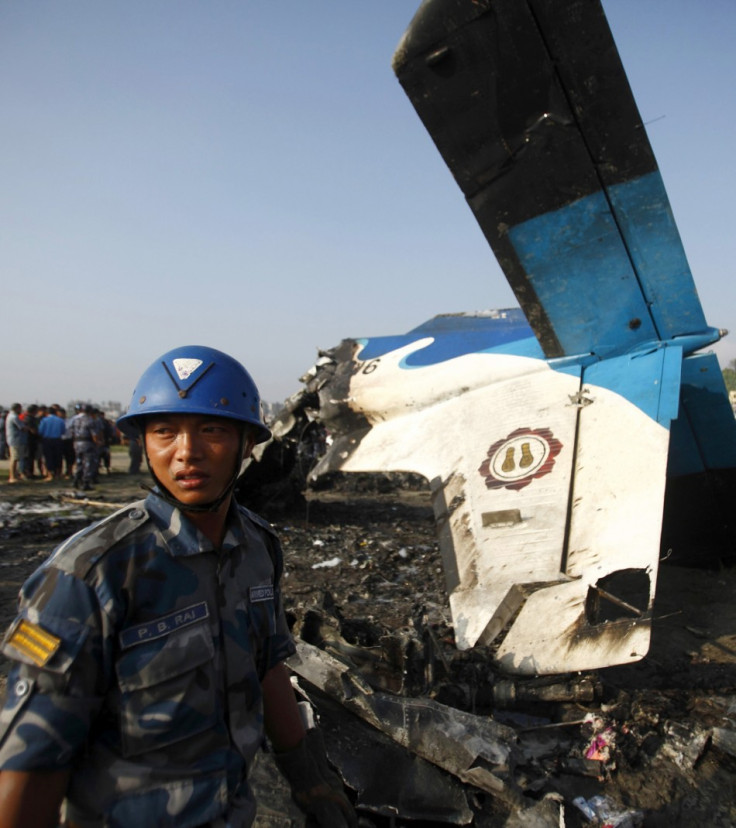Nepal Plane Crash: Kathmandu Catastrophe Latest Example of Nepalese Neglect [BLOG]
Nepal's authorities have failed to address aviation safety for decades, despite repeated tragedies

The crash which killed 19 people, including seven Britons, on the fringes of Kathmandu airport is just the latest in a catalogue of disasters for the Nepalese aviation industry, which appears to have made little provision for the fact that the country is an international tourist hub.
It remains unclear what caused the Dornier plane to crash just two minutes after take-off. Some suggest the plane hit a vulture on its ascent; others postulate that a technical problem brought the aircraft down. However, whatever the cause, the Nepalese authorities' systemic negligence is glaringly apparent.
Nepal has now witnessed five fatal plane crashes in just two years, killing a total of 95 people. Just as damningly, Kathmandu airport has seen nine major crashes in the last 20 years. Of the nine craft involved, two hit surrounding mountains, one struck a communications tower, and one simply failed to take off.
These basic, avoidable causes point to a chronic lack of safety in and around the airfield, exacerbated by Kathmandu's mountainous surroundings. For those in any doubt as to the perils posed to aircraft by Kathmandu's topography, take a look at the following clip:
Even though the doomed Dornier plane took off in perfect weather, one would not envy a pilot who had to negotiate a way into, or out of, such confined, precipitous terrain. And Kathmandu isn't even the most treacherous airport in Nepal; the descent into Lukla airport, the destination of the plane that crashed, looks like it was designed by some reclusive Bond villain - a valley of jagged, verdant mountains opening up at the last minute to reveal the thinnest of airstrips.
Despite these obvious dangers, and the spate of accidents which have blighted the country, it appears the Nepalese have paid scant regard to the issue of aviation safety ever since commercial flights to Kathmandu were sanctioned in 1951.
Negligence starts at the top
According to a report published by the International Flight Safety Exchange in 2009, ranking each of the world's countries in eight key safety areas, Nepal scored just 1/10 for technical training, 4/10 for the provision of technical tools, and 2/10 for the resolution of safety concerns. In the same year, a report by the SEBS Initiative for Aviation Safety said that most private airline operators in Nepal ignore safety regulations and keep their aircraft in lamentably poor condition.
The negligence appears to start at the top. In 2008, a damning report by the Initiative for Aviation Safety in Nepal (IASN) found that the government and aviation authorities had consistently failed to implement basic safety recommendations. Kul Bahadur Limbu, former head of Nepal airlines, said that the government's air crash inquiries "were never made public", while aviation analyst Hemant Aryalm told AFP that, among Nepalese aviation chiefs, there was a tendency "to blame the dead pilot" for crashes rather than look at their own decisions.
Given the government's reluctance to accept its obligations, one should not be surprised that the country's private aviation companies take a similar stance. According to the head of Kathmandu airport, large amounts of rubbish had accumulated around the airport, encouraging local birds to converge. If the Dornier was indeed downed by a rogue vulture, as is claimed, such gross negligence would appear a key secondary factor - as well as a damning indictment of the airport serving Nepal's capital city. One finds it hard to imagine flocks of birds being drawn to airports in London, Paris or New York by piles of rotting garbage.
Meanwhile Sita Air, the company which operated the doomed flight, serves 14 domestic airports with just three planes, all of which are Dornier 228s - a model that has changed little since it came into service in 1981. Nepal's last air crash, on the approach to Jomsom airport in May, also involved a 228; prior to the crash, the flight crew expressed strong reservations about the plane's turn radius and the potential for the wheels to lock up.
In August, aircraft parts service Locatory.com claimed that Nepal's aviation industry was blighted by "ageing regional aircraft" and Dorniers aged between 20 and 30 years old "are still relatively popular." All the evidence would suggest that Sita is as apathetic as any of its rival airlines when it comes to fleet modernisation.
A fortnight ago Britain mulled the report into the Hillsborough disaster, a tragedy caused by the British authorities' disregard for safety and modernisation at the game, despite repeated earlier tragedies. The parallels with the Kathmandu crash are obvious: despite repeated crashes and international warnings, the Nepalese airlines, airports and aviation bodies have paid little or no heed to the dangers around them. Ironically, mortality rates on the Nepalese mountains have been falling, as improved safety measures kick in. Unfortunately, climbers have to survive the journey to the mountains before they begin their ascent - and that is an altogether more perilous task.
© Copyright IBTimes 2025. All rights reserved.




















